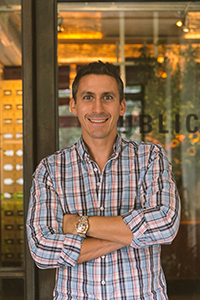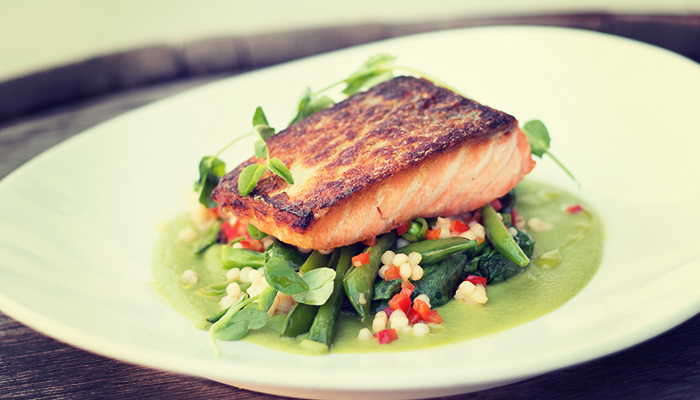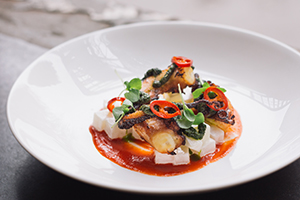
Pittsburgh-raised chef Brad Farmerie has traveled the world seeking inspiration for his cuisine, the results you can see at his award-winning Manhattan restaurant PUBLIC. In 2011, the talented chef opened Saxon + Parole nearby and, most recently, he’s teamed up with JetBlue to launch the gourmet food service component to the airline’s Mint premium coast-to-coast service. Here, Farmerie discusses the high-flying partnership and explains how traveling has inspired what he cooks on the ground.
Are there any tricks to keeping PUBLIC so popular and tasty year after year?
Over the years we have tried to challenge ourselves to outdo what we have accomplished the year before. A lot of it has to do with harnessing the talent and creativity of new people that come and work at the restaurant; bringing a fresh crop of ideas that we can cultivate; and driving the collective creativity so that the whole group knows that we expect change, not stagnation.
You have traveled the world to study food. What was the most inspirational trip?
I had a great four-month trip through Southeast Asia right when we were opening PUBLIC, and it was hugely influential and inspirational. I was able to really surround myself with the culture and cuisines of the regions where I was traveling including Thailand, Laos, Cambodia and Vietnam. I thought that Thailand would have the greatest impact based on where my interests at the time were, but it was Vietnam that amazed me with beautiful landscapes and memorable cuisines. Such light, delicate and nuanced flavors that still rank as one of my favorite food journeys.
Other trips that are up there in terms of inspiration are Morocco, England, India and Singapore. Morocco has its braising and tagine flavors that bring together components of North Africa and the Middle East, plus they place importance on vegetarian dishes, dips, tahini, salty cheeses, lamb and flatbreads. Then, living in England with its historical culinary traditions like sausage making, chutneys and pickles, along with the abundant and incredible cheeses produced in England and southern Ireland [also make it special].
I also had a memorable one-month trip down the west coast of India many years ago with spice mixtures and more vegetarian-based cooking. It was a sensory memory with exotic sights, sounds and smells. And in Singapore, I had a food tour curated by a food-industry friend who showed us the best hawker stalls and the almost-competitive quest for food that drives the local food scene in a city where flavors of China, Southeast Asia, India and Europe all collide and coexist — just what I’m looking for.
Where would you like to go now?
I have been to Japan, but not for any length of time where I could immerse myself in the beautiful food culture that helps define the country. The respect and reverence that is shown for food is such a beautiful thing and makes it first on my list. I haven’t had a chance to venture down to South America and get into the diversity of the many countries and cuisines. It feels like I’ll need a good chunk of time to start chipping away at such a large goal, but at least it is a challenge that I look forward to.
Why did you decide to partner with JetBlue?
JetBlue approached us to partner with them while conceiving their Mint program. I had some initial hesitations. For the most part, the food that I have had on board airplanes has been pretty mediocre, and the idea that I could help change that was exciting yet daunting. Exciting for me to be able to tackle an institution that hasn’t really drastically improved in many years and to affect change at a national level, but daunting because if it were easy to deliver something super tasty and memorable on an airplane, wouldn’t someone else have done it already? I had an inkling that there were many hurdles, from preparation to transportation to presentation. But I could also be convinced to turn a blind eye to these and tackle the challenge. I had never really partnered with a big company before and was worried that their corporate policy and direction could stifle my vision of what we could offer. But after meeting with the group that I would be working with, I was confident that we were all striving for the same thing and could form a really great partnership. And so the deal was done.
What are the challenges of making food for an airline?
There was a long list of factors when we were building the menu. Conceptually, we wanted to have recognizable menu items with a memorable twist so that guests can feel comfortable in their choices, but also have talking points to share with others. We wanted food that pops off of the plate with bright, fresh colors often lacking in the mile-high food world. Another important factor is that taste and smell can have a loss of up to 20 percent at altitude, so we wanted dishes that had flavor bursts that didn’t rely on salt to compensate. So, we used an abundance of fresh herbs and umami boosters like kombu seaweed, dried shiitake mushrooms, anchovy, sun-dried tomatoes and complex spice blends. We also needed to include dishes that could have all of the technique and plating done ahead of time, allowing just a few movements to finish the plate on board.
What’s your most memorable airport or airline meal?
I flew Air New Zealand from NYC to Auckland and had an insanely good experience. Food was by Peter Gordon and was super tasty and creative. He is a friend and mentor, and it was cool to see his vision transfer from The Providores in London to 30,000 feet. I remember the wine selection to be a collection of the best of the best and included a really impressive lineup of producers and great vintages from Kumeu River, Pegasus Bay and Millton Chenin Blanc.
Worst airline meal?
I fly out to Moscow every two months to work at Saxon + Parole Moscow. The carrier that I fly shares their lounge with other airlines, so it’s heavily stocked with instant ramen which, of course, seems a little weird when in NYC and getting ready to go to Moscow. Nonetheless, it is fine. But on board, there are some dishes that definitely don’t translate, possibly due to cultural differences, possibly due to execution. One dish in particular that is memorably unique is a cold beef stew rolled in an equally cold crepe. For some reason, I always feel inclined to pick it up assuming that it will be hot, but six times a year I am proven wrong.



